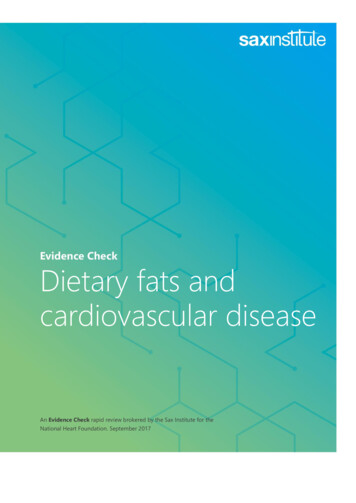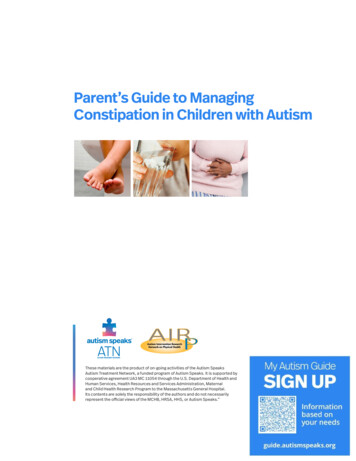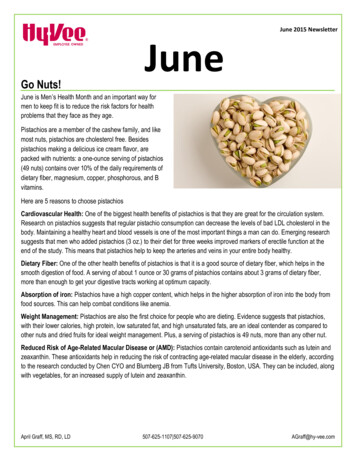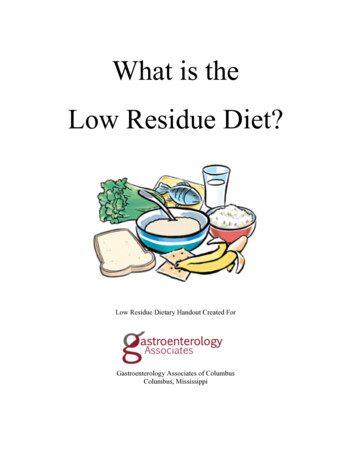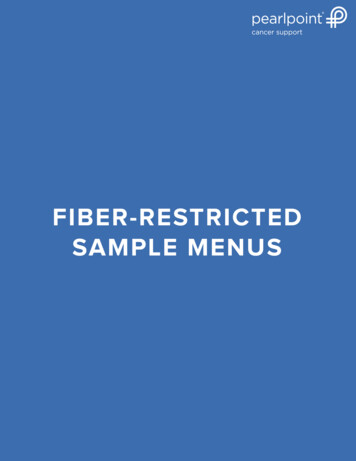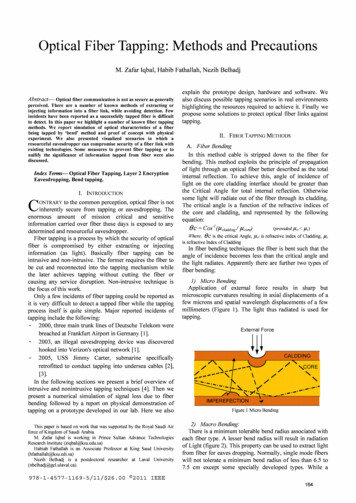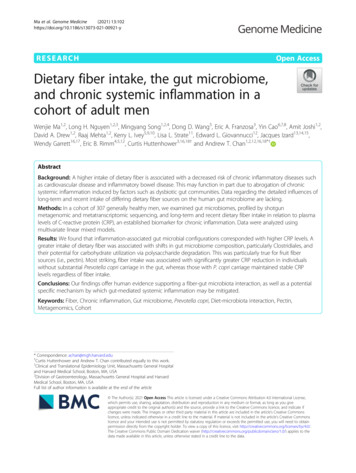
Transcription
Ma et al. Genome Medicine(2021) SEARCHOpen AccessDietary fiber intake, the gut microbiome,and chronic systemic inflammation in acohort of adult menWenjie Ma1,2, Long H. Nguyen1,2,3, Mingyang Song1,2,4, Dong D. Wang5, Eric A. Franzosa3, Yin Cao6,7,8, Amit Joshi1,2,David A. Drew1,2, Raaj Mehta1,2, Kerry L. Ivey5,9,10, Lisa L. Strate11, Edward L. Giovannucci12, Jacques Izard13,14,15,Wendy Garrett16,17, Eric B. Rimm4,5,12, Curtis Huttenhower3,16,18† and Andrew T. Chan1,2,12,16,18*†AbstractBackground: A higher intake of dietary fiber is associated with a decreased risk of chronic inflammatory diseases suchas cardiovascular disease and inflammatory bowel disease. This may function in part due to abrogation of chronicsystemic inflammation induced by factors such as dysbiotic gut communities. Data regarding the detailed influences oflong-term and recent intake of differing dietary fiber sources on the human gut microbiome are lacking.Methods: In a cohort of 307 generally healthy men, we examined gut microbiomes, profiled by shotgunmetagenomic and metatranscriptomic sequencing, and long-term and recent dietary fiber intake in relation to plasmalevels of C-reactive protein (CRP), an established biomarker for chronic inflammation. Data were analyzed usingmultivariate linear mixed models.Results: We found that inflammation-associated gut microbial configurations corresponded with higher CRP levels. Agreater intake of dietary fiber was associated with shifts in gut microbiome composition, particularly Clostridiales, andtheir potential for carbohydrate utilization via polysaccharide degradation. This was particularly true for fruit fibersources (i.e., pectin). Most striking, fiber intake was associated with significantly greater CRP reduction in individualswithout substantial Prevotella copri carriage in the gut, whereas those with P. copri carriage maintained stable CRPlevels regardless of fiber intake.Conclusions: Our findings offer human evidence supporting a fiber-gut microbiota interaction, as well as a potentialspecific mechanism by which gut-mediated systemic inflammation may be mitigated.Keywords: Fiber, Chronic inflammation, Gut microbiome, Prevotella copri, Diet-microbiota interaction, Pectin,Metagenomics, Cohort* Correspondence: achan@mgh.harvard.edu†Curtis Huttenhower and Andrew T. Chan contributed equally to this work.1Clinical and Translational Epidemiology Unit, Massachusetts General Hospitaland Harvard Medical School, Boston, MA, USA2Division of Gastroenterology, Massachusetts General Hospital and HarvardMedical School, Boston, MA, USAFull list of author information is available at the end of the article The Author(s). 2021 Open Access This article is licensed under a Creative Commons Attribution 4.0 International License,which permits use, sharing, adaptation, distribution and reproduction in any medium or format, as long as you giveappropriate credit to the original author(s) and the source, provide a link to the Creative Commons licence, and indicate ifchanges were made. The images or other third party material in this article are included in the article's Creative Commonslicence, unless indicated otherwise in a credit line to the material. If material is not included in the article's Creative Commonslicence and your intended use is not permitted by statutory regulation or exceeds the permitted use, you will need to obtainpermission directly from the copyright holder. To view a copy of this licence, visit http://creativecommons.org/licenses/by/4.0/.The Creative Commons Public Domain Dedication waiver ) applies to thedata made available in this article, unless otherwise stated in a credit line to the data.
Ma et al. Genome Medicine(2021) 13:102BackgroundChronic low-grade systemic inflammation has been associated with several diseases that collectively comprisethe leading causes of death worldwide, including cardiovascular disease, cancer, diabetes mellitus, and chronickidney disease [1]. Emerging evidence from animalmodels has demonstrated that diet plays a critical role indriving host inflammatory responses, predominantlythrough alterations in the composition and metabolicactivities of the gut microbiome, which in turn influencedownstream physiology such as intestinal permeability[2, 3]. However, with scant human population data, ourunderstanding of the complex interplay between diet,specific microbes, and how they affect chronic systemicinflammation remains limited.Numerous epidemiological studies have linked higherdietary fiber intake to reduced risk for several chronicinflammatory diseases [4], with the beneficial effects offiber varying according to fiber types and their foodsources [5–7]. For example, in a meta-analysis of severalprospective cohort studies, insoluble fiber and fiber fromcereals showed the strongest inverse association withrisk of coronary heart disease [5]. Conversely for Crohn’sdisease and diverticulitis, the greatest benefit came fromfruit fiber [6, 7]. Furthermore, fibers are not mechanistically equivalent. Both in vitro and in vivo studies haveshown that discrete structural differences of dietary fibermay induce distinct anti-inflammatory effects [8–10]. Inone study, compared to inulin, apple-derived pectin hada highly specific influence on the gut microbiome composition and strongly promoted Eubacterium eligens [8].However, despite these compelling findings, the mechanisms underlying these heterogeneous associations havenot been fully explored.Independent of health outcomes, decreased dietaryfiber intake has also been associated with gut microbialresponses. These include overall lower gut microbial diversity [11], specific taxonomic changes (particularlyamong microbes involved in fermentation and production of short-chain fatty acids (SCFAs)) [12], and theproduction of these metabolites themselves [13–15].Meanwhile, recent experimental evidence has furtherdemonstrated interactions between dietary fiber and gutmicrobiota composition in the pathogenesis of inflammationby impairing intestinal barrier function and increasing permeability [3, 16, 17]. For instance, mice fed a low-fiber diethad greater Proteobacteria carriage, increased permeability,and a reduced growth rate of the inner mucus layer, whereasBifidobacterium or fiber could prevent these mucus aberrations [16]. In healthy individuals, dietary fiber interventions,particularly involving fructans and galacto-oligosaccharidesthat are highly fermentable, results in enriched abundanceof Bifidobacteria and increased fecal concentrations of beneficial SCFAs, such as butyrate [9, 18].Page 2 of 13We thus performed a population-based study to examine the relationship between dietary fiber intake, the gutmicrobiome, and chronic systemic inflammation. Thisemployed a subcohort of 307 men, the Men’s LifestyleValidation Study (MLVS), nested within the Health Professionals Follow-Up Study (HPFS). We assessed stoolmetagenomes and metatranscriptomes in associationwith long-term and recent dietary fiber intake from various food sources. This served to elucidate the mechanisms underlying the direct effects of fiber intake on themicrobiome and their potential direct and indirect effects on circulating C-reactive protein (CRP), a validatedand widely accepted marker of systemic inflammation.Mildly elevated CRP levels have been associated withrisk of cardiovascular disease and other chronicinflammatory diseases among initially healthy population[19–21]. We found that dietary fiber from fruit sourcesin particular (e.g., pectin) was associated with gut microbiome composition and function, and CRP reductionwith fiber intake was greater in individuals withoutPrevotella copri carriage.MethodsStudy population and stool sample collectionThe Health Professionals Follow-Up Study (HPFS) is anongoing prospective cohort study of 51,529 US malehealth professionals aged 40 to 75 years at enrollment in1986 [22]. Participants have been followed bienniallyquerying lifestyle, medical, and other health-related information, with a follow-up rate greater than 90% ofavailable person-time. For this analysis, we used datafrom a sub-study of the HPFS, the Men’s Lifestyle Validation Study (MLVS), which consisted of 908 men aged65 to 80 years who were free from coronary heart disease, stroke, cancer (except squamous or basal cell skincancer), or major neurological diseases.From 2012 to 2013, we recruited 307 men in theMLVS and collected longitudinal stool samples [23].Participants were asked to provide stool samples fromtwo consecutive bowel movements 24–72 h apart,followed approximately 6 months later by collection of asecond, similar paired samples. Participants placed eachbowel movement into a container with RNAlater andcompleted a questionnaire detailing the date and time ofevacuation, Bristol stool scale, and other relevant information. Paired specimens were stored in the RNAlater fixative at ambient temperature, shipped overnight to theBroad Institute of MIT and Harvard, and stored immediately in 80 C freezers until nucleic acid extraction. Thestool collection method has been detailed and validatedpreviously and showed that self-collection stool using thefixatives provided statistically near-identical multi’omicsdata to fresh frozen samples according to the HumanMicrobiome Project-validated protocol [23–25].
Ma et al. Genome Medicine(2021) 13:102As previously described [23], we used Illumina HiSeqsequencing paired-end (2 101 nucleotides) shotgunsequencing platform. DNA was extracted from 925 samples, in addition to RNA from a subset of 372 samplesfrom 96 participants who provided stool samples duringboth sampling periods and did not report the use ofantibiotics within the past year.Assessment of long-term and recent intake of dietaryfiberIn the HPFS, dietary intake was assessed every 4 yearssince enrollment in 1986 with a validated, semiquantitative Food Frequency Questionnaire (FFQ) [26].Participants were asked how often they typically consumed each food of a standard portion size (e.g., 1 freshapple or pear) during the past year, ranging from “almost never” to “ 6 times per day. Daily intake of eachnutrient was calculated by multiplying the reported frequency of each food item by its nutrient content andsumming across foods, followed by curator quality control. Fiber intake was calculated using the Associationsof Official Analytical Chemists method (accepted by theUS FDA and the World Health Organization for nutrition labeling purposes) [27]. We adjusted fiber intake fortotal caloric intake using the nutrient residual method[28]. FFQs have demonstrated good reproducibility andvalidity for assessing habitual intake; the correlation coefficient comparing dietary fiber assessment from FFQwith multiple 7-day dietary records is 0.68 [26]. To represent long-term intake, we calculated the cumulativeaverage of dietary fiber intake based on seven FFQs priorto the stool collection from 1986 through 2010.Participants in the MLVS were also administered 7day dietary records recording recent diet contemporaneously with stool sample collections. Participants measured and reported gram weights for foods using aPrimo Multifunction Kitchen Scale and ruler before andafter eating, provided recipes of home-prepared foods,and returned labels of store-brand products. The Nutrition Data System for Research was used to derive over150 nutrients and dietary constituents including dietaryfiber intake [29].Taxonomic and functional profilingTaxonomic and functional profiles were generated byusing the bioBakery meta’omics workflow [30]. Sequencing reads were passed through the KneadData 0.3 quality control pipeline (http://huttenhower.sph.harvard.edu/kneaddata) to remove low-quality read bases and readsof human origin. Taxonomic profiling was performedusing MetaPhIAn 2.6.0 (http://huttenhower.sph.harvard.edu/metaphlan2) [31], which classifies the metagenomicreads to taxonomies and yields relative abundances oftaxa identified in the sample based on approximately 1Page 3 of 13million clade-specific marker genes derived from 17,000microbial genomes (corresponding to 13,500 bacterialand archaeal). We excluded microbial species that didnot surpass minimum prevalence (10% of samples) andrelative abundance (0.01%) threshold.Metagenomes and metatranscriptomes were functionally profiled using HUMAnN 2.11.0 (http://huttenhower.sph.harvard.edu/humann) [32]. Briefly, for each sample,taxonomic profiling is used to identify detectable organisms. Reads are recruited to sample-specific pangenomesincluding all gene families in any detected microorganisms using Bowtie2 [33]. Unmapped reads are alignedagainst UniRef90 [34] using DIAMOND translatedsearch [35]. Hits are counted per gene family and normalized for length and alignment quality. For calculatingabundances from reads that map to more than one reference sequence, search hits are weighted by significance(alignment quality, gene length, and gene coverage). UniRef90 abundances from both the nucleotide and proteinlevels were then (1) mapped to level 4 enzyme commission (EC) nomenclature, (2) combined into structuredpathways from MetaCyc [36], and (3) regrouped tocarbohydrate-active enzymes (CAZy) [37]. More detailsabout functional profiling in the MLVS have been described previously [23, 25].Metatranscriptomic functional activity was assessed in372 samples with both RNA and DNA data using RNA/DNA ratios. Owing to the compositionality of RNA andDNA measurements, the resulting ratio is relative to themean transcript abundance of the entire microbial community. Thus, a ratio of 1 implies that the pathway istranscribed at the mean transcription abundance of allpathways in the microbial community. Infinite values ofRNA/DNA ratios were imputed using 99% percentile ofa given feature and values of 0 were imputed using halfof the 1% percentile before log2 transformation. Weexcluded metagenomes and metatranscriptomes that didnot surpass a minimum prevalence (10% for DNA and20% for RNA/DNA ratio) and relative abundance(0.001% for DNA) threshold.Blood sample collection and measurement of CRPThe MLVS collected two fasting blood samples in bloodtubes with liquid sodium heparin during the same periodas fecal sample collection. After collection, tubes wereplaced in styrofoam containers with ice packs, returnedto the laboratory via overnight courier, and centrifugedand aliquoted for storage in liquid nitrogen freezers( 130 C or colder). Plasma levels of high-sensitivity CRPwere measured at the Franke lab at University of Hawaiiusing a Cobas MiraPlus clinical chemistry analyzer(Roche Diagnostics, Indianapolis, IN) and a latex particleenhanced immunoturbidimetry-based kit from PointeScientific (Lincoln Park, MI). We excluded samples with
Ma et al. Genome Medicine(2021) 13:102high-sensitivity CRP levels below ( 0.01 mg/L) or above( 20 mg/dL), the detection limits.Data analysisWe paired longitudinal stool microbiome with concurrent blood measurements and dietary intake, resulting in925 samples for taxonomic and metagenomic analysesand 372 samples for metatranscriptomic analyses. Weused the Bray-Curtis dissimilarity metric to determinethe differences of the taxonomic composition at the species level, functional potential (DNA), and functional activity (RNA/DNA ratio). We performed omnibus testingwith permutational multivariate analysis of variance(PERMANOVA) of Bray-Curtis dissimilarities (999permutations) to quantify the percentage of variance explained by age, lifestyle, diet, and clinical biomarkers.We identified microbial species and functions associatedwith dietary fiber intake and CRP using multivariate linear mixed model in MaAsLin 2 0.99.12 [38]. All modelsincluded each participant’s membership as a random effect to account for within-person variation and were alsoadjusted for covariates including age, recent antibioticuse, and total calorie intake:microbiome features fiber þ age þ antibiotic useþ calorie intakeþ ð1 j participantÞWe additionally adjusted for body mass index (BMI)in the model for CRP to delineate microbial speciesassociated with chronic inflammation independent ofadiposity. To examine an interaction between fiberintake and gut microbiome composition, we applied anequivalent multivariate linear mixed model that includeda product term of fiber and presence of P. copri (fiber: P.copri) in addition to their main effects and evaluated thestatistical significance of the product term:logCRP fiber þ P:copri þ fiber: P:copri þ age þ antibiotic useþ calorie intake þ ð1 j participantÞOverall type I error was controlled using theBenjamini-Hochberg false discovery rate (FDR). A corrected p value of 0.25 was considered as statisticallysignificant, with some results limited to a subset forvisualization and full results in the supplement.ResultsStudy design and populationWe assessed diet-microbiome-inflammation interactionsusing existing data from the MLVS, a cohort of 307generally healthy men nested in the HPFS (Fig. 1A), asdescribed previously [23, 25]. The mean age of MLVSparticipants was 70.6 4.3 years. At the first collection,Page 4 of 13participants had a mean intake of dietary fiber of 25.3 8.1 g/d and a mean CRP level of 1.75 mg/dL (Fig. 1B).Recent intake of dietary fiber was inversely correlatedwith BMI as expected (r 0.24), but not correlated withage (r 0.02) (Fig. 1C). The source of dietary fiber was33% from cereals, 21% from fruits, and 31% from vegetables (Fig. 1D). The majority of participants were physically active, did not smoke, and had normal stoolconsistency as represented by Bristol score; interestingly,these characteristics did not differ by overall fiber intake(Table 1).Baseline inter-individual variation in the gut microbiomedominates effects relative to dietary fiber intakeWe included 925 metagenomes and 372 metatranscriptomes in our analyses [23]. A total of 139 microbial species were retained after quality control from MetaPhlAn2 [31] and gene, transcript, and pathway functional profiles from DNA and RNA using HUMAnN 2 [32].We first tested for associations between overall microbiome structure and our main variables of interest (fibersubsets and CRP) and covariates (Fig. 1E, Additional file1: Figures S1 and S2). Using omnibus testing with PERMANOVA of Bray-Curtis dissimilarities, individual factorsincluding age, lifestyle, diet, and clinical biomarkers onlyexplained a minimal amount of the variation of the gutmicrobiome profile (all R2 0.01; Additional file 1: FigureS2). Among them, recent dietary fiber intake was theleading factor, explaining small but significant variancein taxonomic composition (R2 0.0095, p 0.005) andfunctional potential (R2 0.0085, p 0.001). Thus,neither fiber intake nor CRP levels alone were the maindrivers of overall microbiome configurations, which wereinstead dominated by baseline inter-individual differences [25].Microbiome structure, primarily via Prevotella copricarriage, modifies the association between fiber intakeand plasma CRPWe examined the possibility that the relationship between recent dietary fiber intake and CRP levels was notuniform across the population. Specifically, across thelandscape of gut microbiome configurations (beta-diversity differences), we observed that individuals in the outgroup of high Prevotella copri carriers (a commonsubset of “typical” adult Westernized gut populations)did not appear to maintain the expected protective relationship between increased fiber and lower CRP. Consistent with other findings [39], 24.1% of samples in ourstudy reliably carried P. copri. We tested this interactionquantitatively and found that the inverse association between dietary fiber and CRP was significantly strongeramong participants who did not have P. copri, comparedto those with P. copri carriage (P-interaction 0.01, using
Ma et al. Genome Medicine(2021) 13:102Page 5 of 13Fig. 1 Linking the gut microbiome, dietary fiber, and systemic inflammation in a cohort of adult males. A 307 participants nested within theHealth Professionals Follow-Up Study [23, 25] provided up to four stool samples with concurrent blood samples over a 6-month study period,generating 925 metagenomes from all participants and 372 metatranscriptomes from a subset of 96 selected because they provided stool atboth sampling periods and did not report antibiotic use during the past year. B Overall recent dietary fiber intake and C-reactive protein (as abiomarker of systemic inflammation) levels were distributed representatively across this population. C Recent dietary fiber intake was inverselycorrelated with body mass index as expected (r 0.24), but not correlated with age (r 0.02). D Major food sources of fiber intake includedcereals, vegetables, and fruits. E Principal coordinate analysis based on species-level Bray-Curtis dissimilarity decorated by quartiles of C-reactiveprotein and continuous fruit fiber intake suggested that fiber intake and CRP levels were not the overall largest sources of microbial communityvariability (other fiber subsets in Additional file 1: Figure S1)a model with a product term of the two in addition tocovariates; Fig. 2). We tested the 10 most abundant species and found that P. copri was the only species whoseabundance modified the association between fiber intakeand CRP. We also found similar modulation effects of P.copri at each timepoint separately. For example, theSpearman correlation between recent fiber intake andCRP was 0.08 and 0.24 among samples with and without P. copri carriage at timepoint 1, and 0.04 and 0.31at timepoint 2.These results support that microbiome structure, primarily via P. copri carriage, likely modifies the effects offiber intake in alleviating chronic inflammation. Relatedly, P. copri has previously shown both positive andnegative influences on human health. Some studies havelinked P. copri to improved glucose tolerance and insulinresponses in fiber-rich diets [40, 41]. Others, in contrast,associated P. copri with insulin resistance and glucoseintolerance as well as inflammatory diseases [42–44]. Incombination with recent evidence that Westernizationleads to reduced prevalence and genetic diversity of P.copri [39] and the much greater amount and diversity ofplant-based dietary fiber sources in global diets, our results provide compelling novel evidence for chronic, systemic health consequences of gut microbial metabolismof dietary compounds.Individual members and functions in the microbiome areassociated with recent and long-term fiber intakequantities and CRPIn the absence of overall microbiome shifts with fiber intake or CRP, we next identified individual microbial species associated with these variables using multivariatelinear mixed model in MaAsLin 2 [38] (Fig. 3). Allmodels included one fiber or inflammation outcome ofinterest, each participant’s membership as a random effect, and were also adjusted for covariates including age,recent antibiotic use, and total calorie intake. Consistentwith previous studies [46], both recent and long-termhigher dietary fiber were associated with shifts inClostridiales, the major butyrate producers, includingincreases of Eubacterium eligens, Faecalibacterium
Ma et al. Genome Medicine(2021) 13:102Page 6 of 13Table 1 Characteristics of the 307 MLVS study participants according to quartiles of recent dietary fiber intakeQuartiles of recent dietary fiber intake1 (n 77)2 (n 77)3 (n 77)4 (n 76)Age, years70.0 (4.1)71.9 (4.5)70.0 (4.0)70.2 (4.1)Body mass index, kg/m226.1 (3.2)26.9 (4.5)25.2 (2.9)24.1 (3.3)Physical activity, MET-hrs/week48.2 (39.9)39.3 (31.2)52.4 (42.3)51.1 (32.5)Total energy intake, kcal/d2363 (475)2231 (481)2312(453)2337 (473)Total fiber intake, g/d16.6 (2.6)22.0 (1.4)26.4 (1.4)36.2 (6.5)Cereal fiber, g/d6.2 (1.9)6.9 (1.9)7.7 (2.3)9.5 (3.4)Fruit fiber, g/d3.1 (1.5)4.4 (2.0)5.4 (2.2)6.7 (3.1)Vegetable fiber, g/d6.2 (2.4)7.3 (2.2)7.1 (2.2)8.2 ohol intake, %1–6 e than dailyAntibiotic use, %4.33.61.9029.228.627.821.8Probiotic use, %4.33.611.55.8Current smoker, %2.601.301–2, hard stool14.618.27.412.73–5, normal stool79.278.287.081.86–7, loose stool6.33.65.65.5Bristol score, %Total cholesterol, mg/dL186 (38)182 (41)186 (42)178 (33)HDL cholesterol, mg/dL59.9 (13.7)55.1 (15.0)56.2 (15.3)55.5 (12.9)Total/HDL cholesterol ratio3.2 (0.8)3.4 (0.9)3.4 (0.8)3.3 (0.7)C-reactive protein, mg/dL2.1 (2.8)1.9 (2.9)1.3 (2.1)1.7 (2.5)Values are means (SD) for continuous variables and percentages for categorical variables. Variables that differed across quartiles of recent intake of dietary fiberare bolded (general linear model with F test for continuous variables and Mantel-Haenszel chi-squared test for categorical variables; p 0.05)prausnitzii, and genus Roseburia, but also decreases inClostridium, Lachnospiraceae, and Ruminococcus spp.Increased fiber intake was also associated with increasedrelative abundances of Haemophilus parainfluenzae andBacteroides cellulosilyticus. These associations remainedrobust despite additional adjustment for Bristol scoreand other lifestyle factors including alcohol intake andphysical activity.Greater microbial differences were observed in association with intake of pectin and fiber from fruits and, to alesser extent, cereals, compared to vegetable fiber. Forexample, the findings mentioned above includingpositive associations with E. eligens and F. prausnitziiand inverse associations with Lachnospiraceae andRuminococcus were largely driven by pectin and fruitfiber. The distinct chemical structures of dietary fiberslead to substantial variations in solubility and fermentability and subsequent effects on the microbial composition and functions [9, 10]. Pectin is a soluble dietaryfiber rich in apples, pears, plums, and citrus fruits. Itcomprises a highly complex set of plant cell wall polysaccharides including homo-polygalacturonan, rhamnogalacturonan I, and rhamnogalacturonan II [47]. Our resultswere in line with reports from in vitro and animal studiesthat pectin induced influences on the gut microbiota composition, including increases of Clostridiales such as F.prausnitzii and a highly selective promotion of E. eligensas well as depletion of Bacteroidetes [48–50]. Associationsof soluble and insoluble fiber with microbial species weresimilar (Additional file 1: Figure S3, Additional file 2:Table S2), possibly due to the challenge of differentiatingthe soluble vs. insoluble subtypes through available dietinstruments [51].In multivariate models for CRP, higher CRP was associated with enrichment of B. uniformis, B. salyersale,Barnesiella intestinihominis, and Parabacteroides independent of adiposity. In a previous analysis of 178 olderadult subjects, CRP was positively associated with a
Ma et al. Genome Medicine(2021) 13:102Page 7 of 13Fig. 2 Prevotella copri carriage abrogates the protective effects of recent dietary fiber intake on C-reactive protein. Multivariate linear mixedmodels of log-transformed CRP were fit including recent fiber intake and P. copri carriage (binary), their interaction, accounting for participantmembership as a random effect, and adjusting for age, recent antibiotic use, and total calorie intake. We excluded 137 samples with CRP valuesbelow or above the detection limits, and thus, 788 samples from 277 participants were included in this analysis. The relationship between dietaryfiber and plasma CRP was significantly stronger among participants who did not carry P. copri (0 abundance)metagenomically assembled Bacteroides co-abundancegroup [52]. However, unlike the positive associationobserved here with P. distasonis and P. johnsonii, theformer was shown to alleviate obesity and metabolicdysfunctions via production of succinate and secondarybile acids in mice [53]. Higher CRP levels were alsoassociated with depletion of Lachnospiraceae bacterium3 1 46FAA, E. eligens, and Bifidobacterium bifidum, consistent with their anti-inflammatory effects as shown inexperimental studies [50, 54, 55].Dietary fiber intake in particular recent intake frompectin was also significantly associated with a large number of metagenomic functional pathways (Additional file1: Figure S4, Additional file 2: Table S3) and features(Additional file 1: Figure S5, Additional file 2: Table S4)involved in the metabolism of carbohydrates and aminoacids. A greater total fiber intake was associated withsignificant enrichment of PWY-7456 β-(1,4)-mannandegradation, P124 Bifidobacterium shunt, PWY-5104 Lisoleucine biosynthesis IV, and PWY-6305 putrescinebiosynthesis, whereas the rest of pathways were generallydepleted. A higher intake of total fiber and pectin wasalso associated with significantly enriched expression ofEC 3.2.1.4, an endoglucanase (hydrolyzing of (1,4)-betaD-glucan linkages in cellulose) and EC 2.4.1.1 (glycogenphosphorylase), both of which play a role in catalyzingthe degradation of glycans or polysaccharides.Potential biochemical contributors to microbe-specificselection pressures from dietary fiberTo specifically investigate fiber intake in relation tofunctional capacity and activity relating to carbohydrateutilization, we further mapped gene families intocarbohydrate-active enzymes (CAZy) [37]. CAZy coversenzymes catalyzing the breakdown, biosynthesis, ormodification of carbohydrates and glycoconjugates including glycoside hydrolases (GHs), glucosylTransferases(GTs), polysaccharide lyases (PLs), carbohydrate esterases (CEs), auxiliary activities (AAs), and non-catalyticcarbohydrate-binding modules (CBMs). We excludedenzymes that did not surpass a minimum prevalence(10% of samples for CAZy DNA and 20% for RNA/DNAratio) and relative abundance (0.001% for CAZy DNA)threshold, resulting in 134 DNA CAZys and 121 RNA/DNA features in the analysisWe identified a total of 84 CA
health professionals aged 40 to 75 years at enrollment in 1986 [22]. Participants have been followed biennially querying lifestyle, medical, and other health-related in-formation, with a follow-up rate greater than 90% of available person-time. For this analysis, we used data from a sub-study of the HPFS, the Men's Lifestyle Valid-

